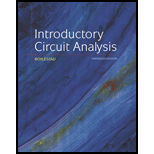
Introductory Circuit Analysis (13th Edition)
13th Edition
ISBN: 9780133923605
Author: Robert L. Boylestad
Publisher: PEARSON
expand_more
expand_more
format_list_bulleted
Question
Chapter 2, Problem 7P
To determine
(a)
The force of repulsion between the charges
To determine
(b)
The values of the charges
Expert Solution & Answer
Want to see the full answer?
Check out a sample textbook solution
Students have asked these similar questions
a) Determine the setting of the overload protection of the circuit breaker intended to protect a 50hp, 380V, IV-pole motor, powered by a unipolar copper-PVC conductor circuit, with a cross-section of 25mm², installed in a buried conduit: The short-circuit current at the motor terminal is 5KA. It is assumed that the overload current of the conductor throughout its useful life is controlled and will not exceed 100 hours for 12 consecutive months or 500 hours throughout the useful life of the conductor. Data: fp = 0.86; efficiency = 0.92
a) Determine the minimum operating time of the circuit breaker in the event of a short-circuit at the motor terminals.
Q1:A: Derive four elements only of diagonals Jacobian matrix of NR method in polar coordinate
for a system consist of 4 buses, bus 1 is slack and the other three buses are PQ buses.
Pls show neat and whole solution
Chapter 2 Solutions
Introductory Circuit Analysis (13th Edition)
Ch. 2 - The numbers of orbiting electrons in aluminum and...Ch. 2 - Find the force of attraction in newtons between...Ch. 2 - Find the force of repulsion in newtons between Q1...Ch. 2 - Plot the force of attraction (in newtons) versus...Ch. 2 - Prob. 5PCh. 2 - Determine the distance between two charges of 20 C...Ch. 2 - Prob. 7PCh. 2 - 8. What is the voltage between two points if 1.2 J...Ch. 2 - If the potential difference between two points is...Ch. 2 - Find the charge in coulombs that requires 200J of...
Ch. 2 - How much charge passes through a radio battery of...Ch. 2 - How much energy in electron volts is required to...Ch. 2 - Find the current m amperes if 96 mC of charge pass...Ch. 2 - If 312 C of charge pass through a wire in 2 min,...Ch. 2 - If a current of 40 mA exists for 1.2 min, how many...Ch. 2 - How many coulombs of charge pass through a lamp in...Ch. 2 - If the current in a conductor is constant at 2 mA,...Ch. 2 - If 21.84710+18 electrons pass through a wire in 12...Ch. 2 - How many electrons pass through a conductor in 5...Ch. 2 - Will a fuse rated at 1 A blow if 86 C pass through...Ch. 2 - If 0.8410+16 electrons pass through a wire in 60...Ch. 2 - Which would you prefer? A penny for every electron...Ch. 2 - If a conductor with a current of 200 mA passing...Ch. 2 - Charge is flowing through a conductor at the rate...Ch. 2 - The potential difference between two points in an...Ch. 2 - What current will a battery with an Ah rating of...Ch. 2 - What is the Ah rating of a battery that can...Ch. 2 - For how many hours will a battery with an Ah...Ch. 2 - A standard 12 V car battery has an ampere-hour...Ch. 2 - Prob. 30PCh. 2 - What is the percentage loss in ampere-hour rating...Ch. 2 - Using the graph of Fig. 2.27, how much longer can...Ch. 2 - A portable television using a 12 V, 3 Ah...Ch. 2 - Discuss two properties of the atomic structure of...Ch. 2 - Explain the terms Insulator and breakdown...Ch. 2 - List three uses of insulators not mentioned in...Ch. 2 - Using Table 2.2, determine the level of applied...Ch. 2 - What is a semiconductor? How does it compare with...Ch. 2 - Consult a semiconductor electronics text and note...Ch. 2 - What are the significant differences in the way...Ch. 2 - Compare analog and digital scales: Which are you...
Knowledge Booster
Similar questions
- 1. For the following logic gates: a. Write a Truth Table and logic equation? A Y A A. Y A Y "0" A A neotoof "0"> Day Y "1" A ADY DY A B DD A B b. What each of these gates represent? 2. Connect and draw the following digital logic equations: a. Y=X+1 b. Y=X+X' = \ c. Y=X X' d. Y=X 0 e. Y=XX' f. Y=XOX 3. Prove that: a. X(Y+Z)=XY+XZ b. X+YZ=(X+Y)(X+Z) c. (X+Y)'=X'Y' d. (XY)'=X'+Y e. X+XY=X f. X(X+Y)=Xarrow_forwardI need help with this problem and an step by step explanation of the solution from the image described below. (Introduction to Signals and Systems: Spectrum Representation)arrow_forwardI need help with this problem and an step by step explanation of the solution from the image described below. (Introduction to Signals and Systems: A complex Numbers)arrow_forward
arrow_back_ios
SEE MORE QUESTIONS
arrow_forward_ios
Recommended textbooks for you
 Introductory Circuit Analysis (13th Edition)Electrical EngineeringISBN:9780133923605Author:Robert L. BoylestadPublisher:PEARSON
Introductory Circuit Analysis (13th Edition)Electrical EngineeringISBN:9780133923605Author:Robert L. BoylestadPublisher:PEARSON Delmar's Standard Textbook Of ElectricityElectrical EngineeringISBN:9781337900348Author:Stephen L. HermanPublisher:Cengage Learning
Delmar's Standard Textbook Of ElectricityElectrical EngineeringISBN:9781337900348Author:Stephen L. HermanPublisher:Cengage Learning Programmable Logic ControllersElectrical EngineeringISBN:9780073373843Author:Frank D. PetruzellaPublisher:McGraw-Hill Education
Programmable Logic ControllersElectrical EngineeringISBN:9780073373843Author:Frank D. PetruzellaPublisher:McGraw-Hill Education Fundamentals of Electric CircuitsElectrical EngineeringISBN:9780078028229Author:Charles K Alexander, Matthew SadikuPublisher:McGraw-Hill Education
Fundamentals of Electric CircuitsElectrical EngineeringISBN:9780078028229Author:Charles K Alexander, Matthew SadikuPublisher:McGraw-Hill Education Electric Circuits. (11th Edition)Electrical EngineeringISBN:9780134746968Author:James W. Nilsson, Susan RiedelPublisher:PEARSON
Electric Circuits. (11th Edition)Electrical EngineeringISBN:9780134746968Author:James W. Nilsson, Susan RiedelPublisher:PEARSON Engineering ElectromagneticsElectrical EngineeringISBN:9780078028151Author:Hayt, William H. (william Hart), Jr, BUCK, John A.Publisher:Mcgraw-hill Education,
Engineering ElectromagneticsElectrical EngineeringISBN:9780078028151Author:Hayt, William H. (william Hart), Jr, BUCK, John A.Publisher:Mcgraw-hill Education,

Introductory Circuit Analysis (13th Edition)
Electrical Engineering
ISBN:9780133923605
Author:Robert L. Boylestad
Publisher:PEARSON

Delmar's Standard Textbook Of Electricity
Electrical Engineering
ISBN:9781337900348
Author:Stephen L. Herman
Publisher:Cengage Learning

Programmable Logic Controllers
Electrical Engineering
ISBN:9780073373843
Author:Frank D. Petruzella
Publisher:McGraw-Hill Education

Fundamentals of Electric Circuits
Electrical Engineering
ISBN:9780078028229
Author:Charles K Alexander, Matthew Sadiku
Publisher:McGraw-Hill Education

Electric Circuits. (11th Edition)
Electrical Engineering
ISBN:9780134746968
Author:James W. Nilsson, Susan Riedel
Publisher:PEARSON

Engineering Electromagnetics
Electrical Engineering
ISBN:9780078028151
Author:Hayt, William H. (william Hart), Jr, BUCK, John A.
Publisher:Mcgraw-hill Education,